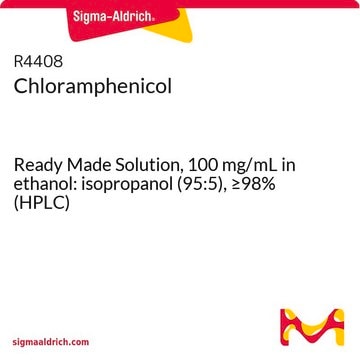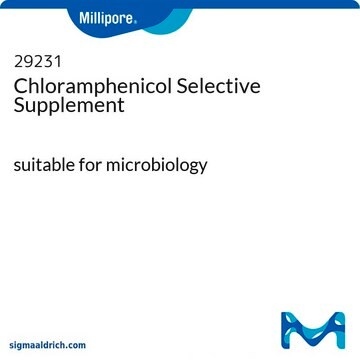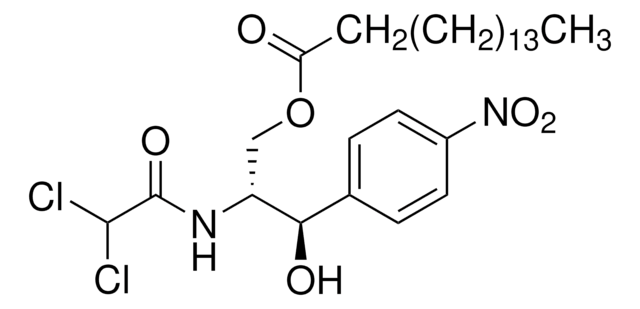C3175
クロラムフェニコール-水溶性
powder, suitable for cell culture, BioReagent
別名:
Chloramphenicol, Chlornitromycin, Chlorocid, Chloromycetin, Cloramfenicol, D-(−)-threo-2-Dichloroacetamido-1-(4-nitrophenyl)-1,3-propanediol, D-(−)-threo-2,2-Dichloro-N-[β-hydroxy-α-(hydroxymethyl)-β-(4-nitrophenyl)ethyl]acetamide, Chloromycetin, D-threo-2,2-Dichloro-N-[β-hydroxy-α-(hydroxymethyl)-4-nitrophenethyl]aceta, Kloramfenikol
About This Item
おすすめの製品
product name
クロラムフェニコール-水溶性, powder, BioReagent, suitable for cell culture
製品種目
BioReagent
形状
powder
テクニック
cell culture | mammalian: suitable
溶解性
H2O: 50-500 mg/mL (stock solution)
PBS: 50-500 mg/mL (stock solution)
other salt solutions: not recommended
抗生物質活性スペクトル
Gram-negative bacteria
Gram-positive bacteria
mycobacteria
mycoplasma
作用機序
protein synthesis | interferes
関連するカテゴリー
アプリケーション
- 大腸菌を培養するためのLuria-Bertani(LB)培地におけるサプリメントとして
- Citrobacter rodentiumを培養するためのLB寒天におけるサプリメントとして
- トキソプラズマ原虫の培養
生物化学的/生理学的作用
包装
その他情報
シグナルワード
Danger
危険有害性情報
危険有害性の分類
Carc. 2 - Eye Dam. 1 - Repr. 2
保管分類コード
11 - Combustible Solids
WGK
WGK 3
引火点(°F)
Not applicable
引火点(℃)
Not applicable
個人用保護具 (PPE)
Eyeshields, Gloves, type P2 (EN 143) respirator cartridges
適用法令
試験研究用途を考慮した関連法令を主に挙げております。化学物質以外については、一部の情報のみ提供しています。 製品を安全かつ合法的に使用することは、使用者の義務です。最新情報により修正される場合があります。WEBの反映には時間を要することがあるため、適宜SDSをご参照ください。
労働安全衛生法名称等を表示すべき危険物及び有害物
名称等を表示すべき危険物及び有害物
労働安全衛生法名称等を通知すべき危険物及び有害物
名称等を通知すべき危険物及び有害物
Jan Code
C3175-BULK:
C3175-100MG:
C3175-VAR:
試験成績書(COA)
製品のロット番号・バッチ番号を入力して、試験成績書(COA) を検索できます。ロット番号・バッチ番号は、製品ラベルに「Lot」または「Batch」に続いて記載されています。
この製品を見ている人はこちらもチェック
資料
Antibiotic kill curve is a dose response experiment in which mammalian cells are subjected to increasing amounts of selection antibiotic
微生物死滅曲線は、哺乳類細胞に対し選択抗生物質のばく露量を増やしていく用量反応実験です。
ライフサイエンス、有機合成、材料科学、クロマトグラフィー、分析など、あらゆる分野の研究に経験のあるメンバーがおります。.
製品に関するお問い合わせはこちら(テクニカルサービス)








